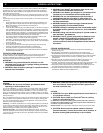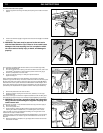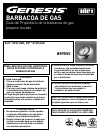Special offers from our partners!

Find Replacement BBQ Parts for 20,308 Models. Repair your BBQ today.

Buy Weber Grill Parts. It couldn't be easier. Find your Weber parts here.

13
WWW.WEBER.COM
®
13
GAS INSTRUCTIONS
SAFE HANDLING TIPS FOR LIQUID PROPANE GAS CYLINDERS
• Liquid Propane (LP) gas is a petroleum product as are gasoline and natural gas.
LP gas is a gas at regular temperatures and pressures. Under moderate pressure,
inside a cylinder, LP gas is a liquid. As the pressure is released, the liquid readily
vaporizes and becomes gas.
• LP gas has an odor similar to natural gas. You should be aware of this odor.
• LP gas is heavier than air. Leaking LP gas may collect in low areas and prevent
dispersion.
• To fi ll, take the LP cylinder to a gas propane dealer, or look up “gas-propane” in the
phone book for other sources of LP gas.
ƽ WARNING: We recommend that your LP cylinder be fi lled
at an authorized LP gas dealer, by a qualifi ed attendant,
who fi lls the tank by weight. IMPROPER FILLING IS
DANGEROUS.
• Air must be removed from a new LP cylinder before the initial fi lling. Your LP dealer
is equipped to do this.
• The LP cylinder must be installed, transported and stored in an upright position.
LP cylinders should not be dropped or handled roughly.
• Never store or transport the LP cylinder where temperatures can reach 125° F (too hot
to hold by hand - for example: do not leave the LP cylinder in a car on a hot day).
Note: A refi ll will last about 18-20 hours of cooking time at normal use. The fuel scale will
indicate the propane supply so you can refi ll before running out. You do not have to run
out before you refi ll.
• Treat “empty” LP cylinders with the same care as when full. Even when the LP tank
is empty of liquid there still may be gas pressure in the cylinder. Always close the
cylinder valve before disconnecting.
ƽ CAUTION: Place dust cap on cylinder valve outlet whenever
the cylinder is not in use. Only install the type of dust cap
on the cylinder valve outlet that is provided with the cylinder
valve. Other types of caps or plugs may result in leakage of
propane.
• Do not use a damaged LP cylinder. Dented or rusty LP cylinders or LP cylinders
with a damaged valve may be hazardous and should be replaced with a new one
immediately.
Liquid Propane (LP) Cylinder(s)
• The joint where the hose connects to the LP cylinder must be leak tested each
time the LP cylinder is reconnected. For example, test each time the LP cylinder is
refi lled.
• Be sure the regulator is mounted with the small vent hole pointed downward so that
it will not collect water. This vent should be free of dirt, grease, bugs etc.
• The gas connections supplied with your Weber
®
gas barbecue have been designed
and tested to meet 100% CSA and ANSI requirements.
ƽ WARNING: Replacement LP tanks must match the regulator
connection supplied with this barbecue.
Liquid Propane Cylinder requirements
• Check to be sure cylinders have a D.O.T. certifi cation (1), and date tested (2) is
within fi ve years. Your LP gas supplier can do this for you.
• All LP tank supply systems must include a collar to protect the cylinder valve.
• The LP cylinder must be a 20-lb. size approximately (18¼ inches high, 12¼ inches
in diameter).
• The cylinder should be constructed and marked in accordance with the
Specifi cations for LP - Gas Cylinders of the U.S. Department of Transportation
(D.O.T.) or the National Standard of Canada, CAN/CSA-B339, Cylinders, Spheres
and Tubes or Transportation of Dangerous Goods; and Commission, as applicable.
In Canada
Liquid Propane Cylinder requirements
Note: Your retailer can help you match a replacement tank to your barbecue.
• The LP cylinder must be constructed and marked in accordance with the
specifi cations for LP gas cylinders, T.C.
DOT 4BA240
00/06
2
1
GAS INSTRUCTIONS
LIGHTING
Summary lighting instructions are inside the left hand cabinet door.
ƽ DANGER
Failure to open the lid while igniting the barbecue’s burners,
or not waiting 5 minutes to allow the gas to clear if the
barbecue does not light, may result in an explosive fl ame-up
which can cause serious bodily injury or death.
Crossover
®
Ignition System
Note: The Crossover
®
Ignition System ignites BURNER 1 with a spark from the igniter
electrode inside the Gas Catcher
™
ignition chamber. You generate the energy for the
spark by pushing the electronic ignition button. You will hear it sparking.
ƽ WARNING: Check hose before each use of barbecue for nicks,
cracking, abrasions or cuts. If the hose is found to be damaged
in any way, do not use the barbecue. Replace using only
Weber
®
authorized replacement hose. Contact the Customer
Service Representative in your area using the contact
information on our web site. Log onto www.weber.com
®
.
OPERATING INSTRUCTIONS


















